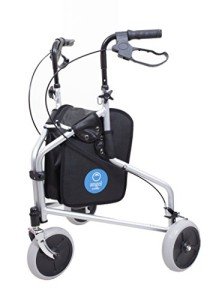Understanding Rollators with Wheels: A Comprehensive Guide
Rollators, also referred to as wheeled walkers, have actually ended up being progressively popular among individuals looking for mobility support. These ingenious devices supply a combination of support, stability, and benefit, making them ideal for seniors and people with disabilities. This post checks out the features, benefits, types, and considerations of rollators with wheels, along with frequently asked concerns to assist you make an informed choice.

What is a Rollator?
A Rollator With Wheels is a mobility gadget geared up with 3 or 4 wheels, hand brakes, and a frame created for stability. Unlike conventional walkers, which require users to raise the device to move, rollators glide efficiently, permitting users to walk naturally while receiving support. The majority of rollators likewise include a seat for resting, making them particularly advantageous for those who may tire easily.
Secret Features of Rollators
- Wheels: Generally designed with either 3 or four wheels, providing balance and stability while walking.
- Hand Brakes: These brakes enable users to stop the rollator safely while promoting self-confidence throughout use.
- Seat: Many rollators come geared up with a seat for resting, ideal for users who may need to take breaks throughout walks.
- Basket or Storage Bag: Convenient for bring individual items, shopping, or fundamentals during getaways.
- Adjustable Height: Frames are often adjustable for a custom fit, accommodating users of different heights.
Benefits of Using a Rollator with Wheels
Rollators provide various advantages for people with limited mobility. A few of the key benefits consist of:
- Enhanced Mobility: Rollators allow users to preserve independence and mobility, making it simpler to browse inside your home and outdoors.
- Enhanced Stability: The presence of wheels and brakes provides extra assistance, lowering the risk of falls.
- Benefit of Use: Users can stroll naturally without needing to lift the gadget, which can minimize pressure on the arms and back.
- Comfortable Seating: Users can take breaks whenever needed, decreasing fatigue and allowing longer getaways.
- Increased Confidence: With much better support and stability, users may feel more secure in their movements, leading to higher mobility.
Kinds of Rollators
When thinking about a rollator, a variety of alternatives are readily available to cater to varied requirements:
Standard Rollators: Typically come with 4 wheels, bigger frames, and a comfy seat, making them suitable for a lot of users.
Compact Rollators: Designed for indoor use or travel, these rollators are lightweight, foldable, and often include smaller sized frames.
Durable Rollators: Engineered for users who might need additional assistance, these rollators normally have a higher weight capacity and a bigger frame.
Three-Wheeled Rollators: More maneuverable than their four-wheeled counterparts, these rollators are ideal for navigating tighter spaces.
Considerations Before Purchasing a Rollator
Before buying a rollator, there are several factors that must be considered to guarantee the best fit for private requirements:
- Weight Capacity: Check the weight limitation to ensure it supports the user's weight properly.
- Frame Size: Ensure that the frame fits the user's height for optimal comfort and support.
- Wheel Size: Larger wheels are generally better for outdoor use and rough terrain, while smaller sized wheels are more suited for indoor use.
- Storage Options: Consider just how much storage is required for mobility aids, shopping, or personal items.
- Mobility: If travel is a top priority, decide for a foldable and lightweight model for ease of transportation.
Upkeep of Rollators
Correct maintenance can prolong the life of a rollator and make sure safety during use. Here are some pointers:
- Regularly Check Brakes: Ensure that hand brakes work effectively and adjust them as required.
- Inspect Wheels: Look for wear and tear; change wheels if they reveal signs of damage.
- Tighten Up Loose Parts: Regularly look for any loose screws or bolts and tighten them to preserve stability.
- Tidy the Frame: Wipe down the frame frequently to keep it devoid of dirt and particles.
Table: Comparison of Rollator Types
| Type of Rollator | Wheel Count | Suitable Use | Weight Capacity | Mobility |
|---|---|---|---|---|
| Requirement Rollator | 4 | General mobility | 300 pounds | Moderate |
| Compact Rollator | 4 | Indoor/Travel | 250 lbs | High |
| Sturdy Rollator | 4 | Rigorous use | 400 lbs | Low |
| Three-Wheeled Rollator | 3 | Tight spaces | 300 pounds | Moderate |
Frequently asked questions About Rollators with Wheels
Q1: How do I pick the best rollator for my needs?
A1: Consider aspects such as your height, weight, and where you'll mainly use the rollator (indoor vs. outdoor). A trial at a mobility shop might likewise assist you discover a comfortable fit.
Q2: Are rollators hard to maneuver?
A2: Most rollators are created for ease of use, and with practice, users typically find them easy to steer, specifically those with turning wheels.
Q3: What is the typical cost of a rollator?
A3: Prices can vary considerably, from around ₤ 70 for basic designs to over ₤ 300 for high-end or specific models.
Q4: Can rollators be used outdoors?
A4: Yes, numerous rollators are created for both indoor and outdoor use. Nevertheless, selecting one with larger wheels can enhance stability on irregular terrain.
Q5: How do I keep my rollator?
A5: Regularly examine the brakes and wheels for wear, tighten up any loose parts, and tidy the frame periodically to make sure safety and longevity.
Rollators with wheels are essential mobility aids that promote independence and security for users. By understanding the functions, benefits, and upkeep of rollators, people can make educated decisions about their mobility needs. With the ideal rollator, users can take pleasure in better mobility, self-confidence, and lifestyle.
